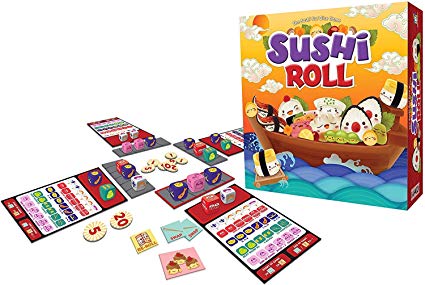Sushi and dice are a winning combination you will not find on any menu. Sushi Roll takes the popular game Sushi Go and instead of card drafting players draft dice. The game is for ages eight and up and can play two to five players. Like it predecessor it is easy to learn and quick to play.

Components
- 40 scoring tokens
- 30 dice
- 20 pudding tokens
- 18 menu tokens
- 12 chopsticks tokens
- 5 conveyor belts
- 5 trays
- 1 dice bag

Gameplay
Set up
To begin, each player takes a tray and places it in front of them. Next, player put the chopstick and the menu tokens in the center of play area. Each player takes two chopstick and three menu tokens to begin the game. The dice are all put in the dice bag and it shaken to mix. The conveyor belts are shuffled, including the one with the red border. Each player receives a conveyor belt. Players draw dice from the bag, the number of dice per player depends on the number of players.
Gameplay
At the start of a round, all players take the dice they drew from the bag, roll their dice, and place them on their conveyor belt without changing them. Next, beginning with the player who has the conveyor belt with the red boarder, player have the option to use a menu token and/or a chopsticks token. The menu token allows a player to re-roll any of their dice, but they must keep the result of the roll. With chopsticks tokens players may switch one of the dice on their conveyor belt with a die on another player’s conveyor belt. The face of the die does not change. These actions may be done multiple times provided the player has the tokens to spend.

Next, the player then selects one die from their conveyor belt and without changing its face places it on their tray. Scoring occurs at the end of the round. If a player takes a Pudding , Menus, or Chopsticks dice they immediately take a token or tokens equal to the number of icons on that face of the die. Players who have a wasabi die and select a nigiri place the nigiri on top of the wasabi, since together they triple in value.
Once all players have selected their die, they simultaneously side their conveyor belts to the left. Each player re-rolls the dice in their conveyor belt and returns the dice to the belt. Players repeat the section steps, and again slide the conveyor belts once everyone has selected. The process repeats until all dice have been selected. That ends the round and players score the dice on their tray. Players take scoring tokens to track their score so far.
To begin a new round all the dice player return the dice to the bag, shaken, and redrawn by each player. Players complete three rounds and calculate final scores at the conclusion of the game. At the end of the game, players count and scored
pudding tokens as well as any remaining chopsticks or menu tokens.
Family Game Assessment
Sushi Roll is a great game to learn the mechanic of drafting. The game has a very simple drafting mechanic using dice. In card drafting players need to remember what cards they saw as the hands were passed. With the dice, the information about available dice is open to all. This open information allowed for more coaching to new or younger players while learning the game.

The trays are well designed to support player and have the information they need to make strategic selections. By listing the different sushi, it allows players to see the values for each piece of sushi. The scoring tokens also allow players to keep track of their score without needing to write it down. This streamlining of information and score keeping also helps the game span generations and abilities.
The game box is a larger box to accommodate all the components, which makes the game less portable than it’s predecessor. It is a worthy trade off to get the additional components in exchange for portability. For anyone that has played Sushi Go, the differences can be picked up in just a few minutes. Those new to the game will find it is easy to pick up and quick to learn.
Final Thoughts
For families that know and love the game Sushi Go, or just enjoy dice and sushi, Sushi Roll is a must addition to any game collection.
What do you think? Sound off in the comments and let us know your thoughts!
Make sure to keep your eyes on Engaged Family Gaming for all of the latest news and reviews you need to Get Your Family Game On!
Follow us on Facebook!
Like us on Twitter!
Follow us on Instagram!
Subscribe to our Newsletter!
Subscribe to our Podcast!
